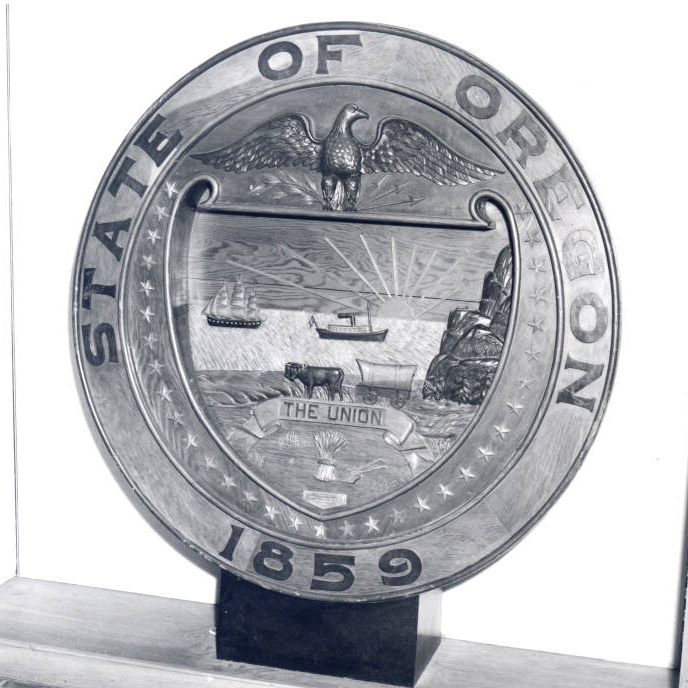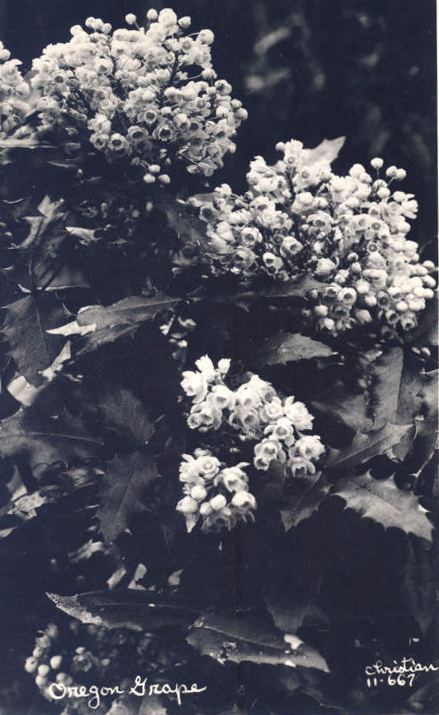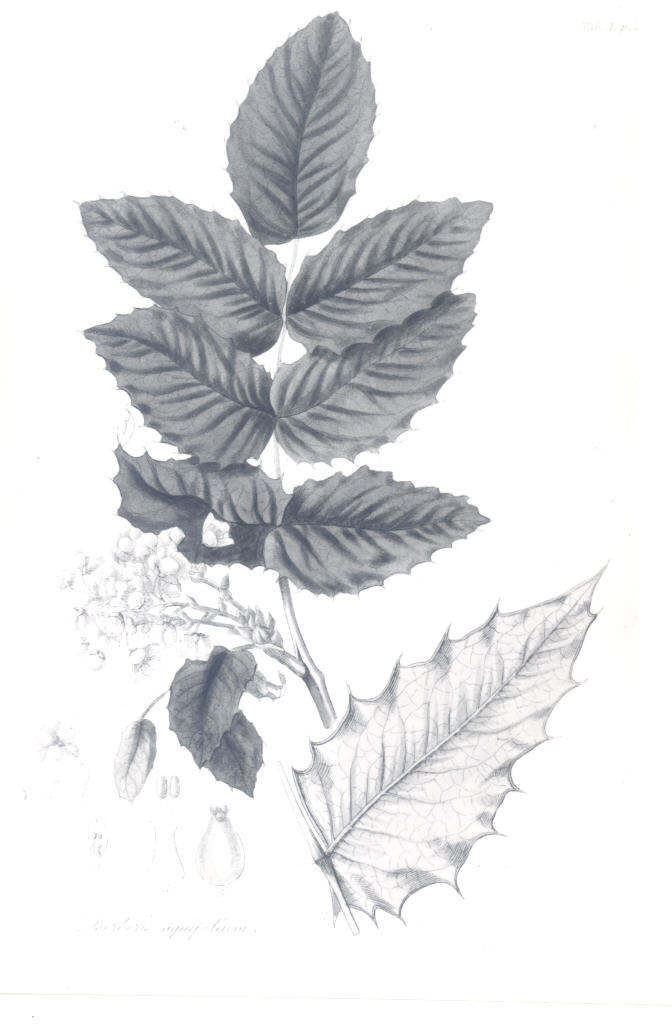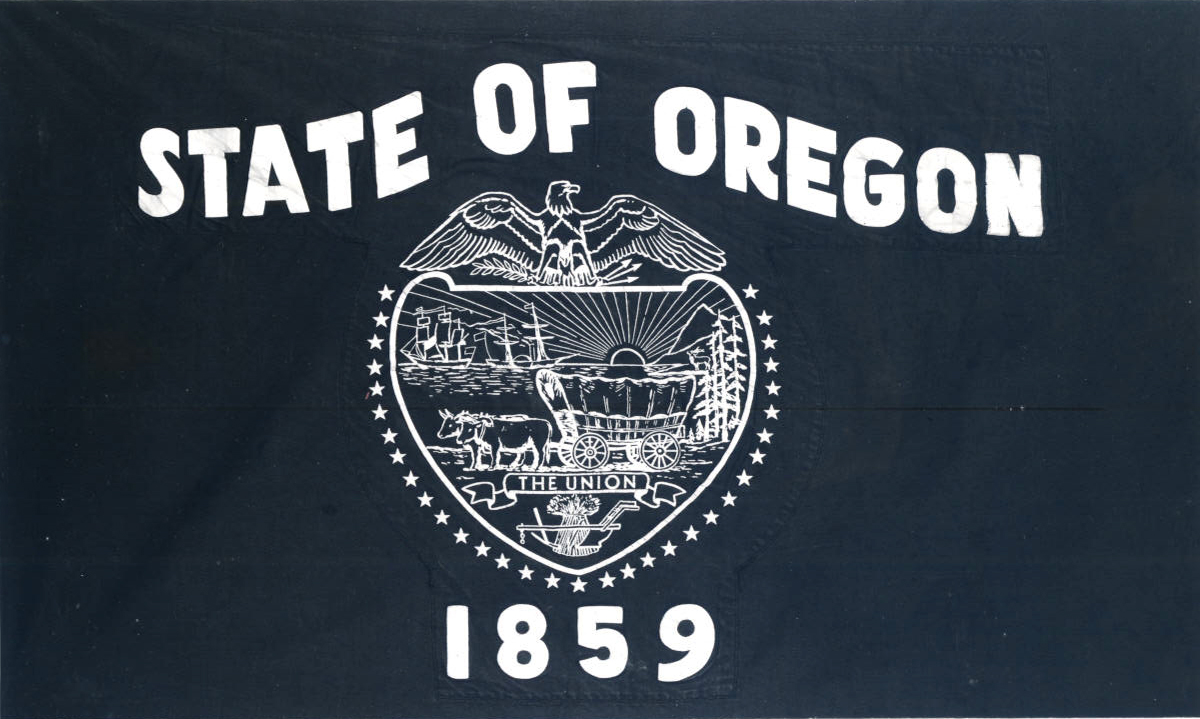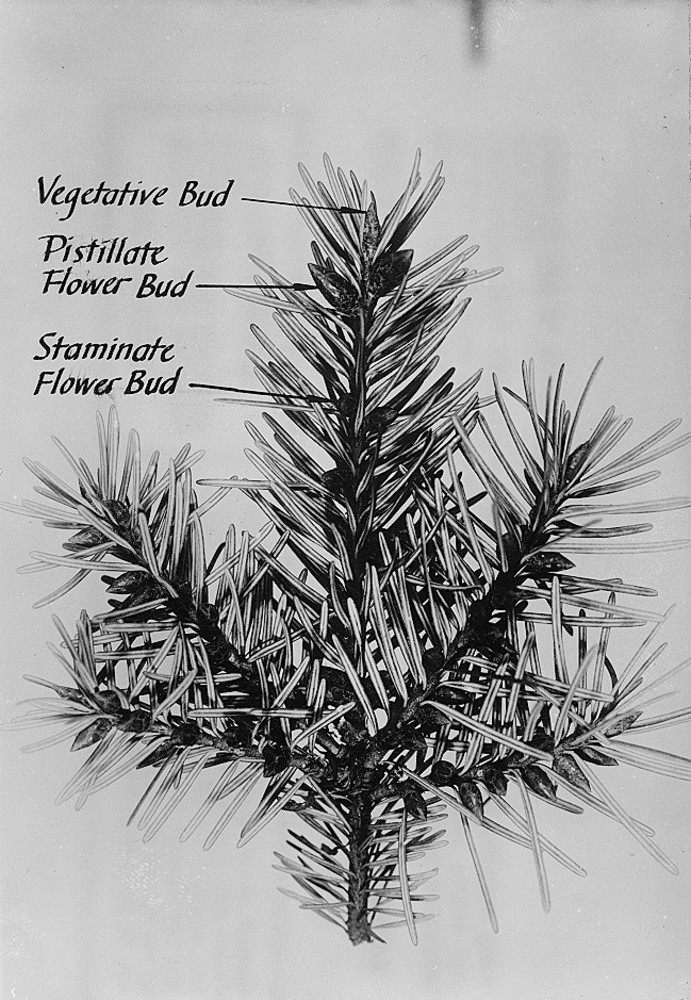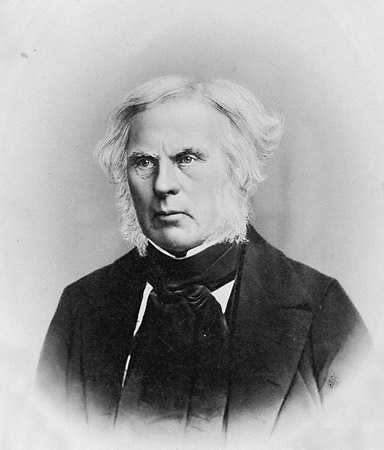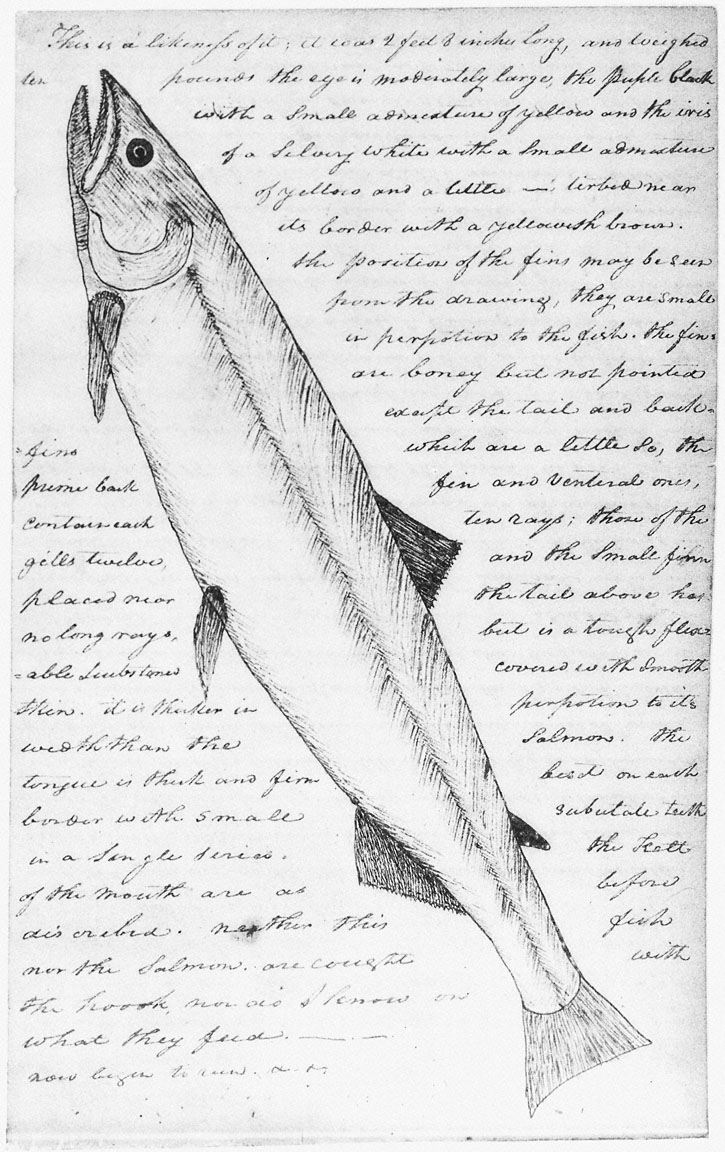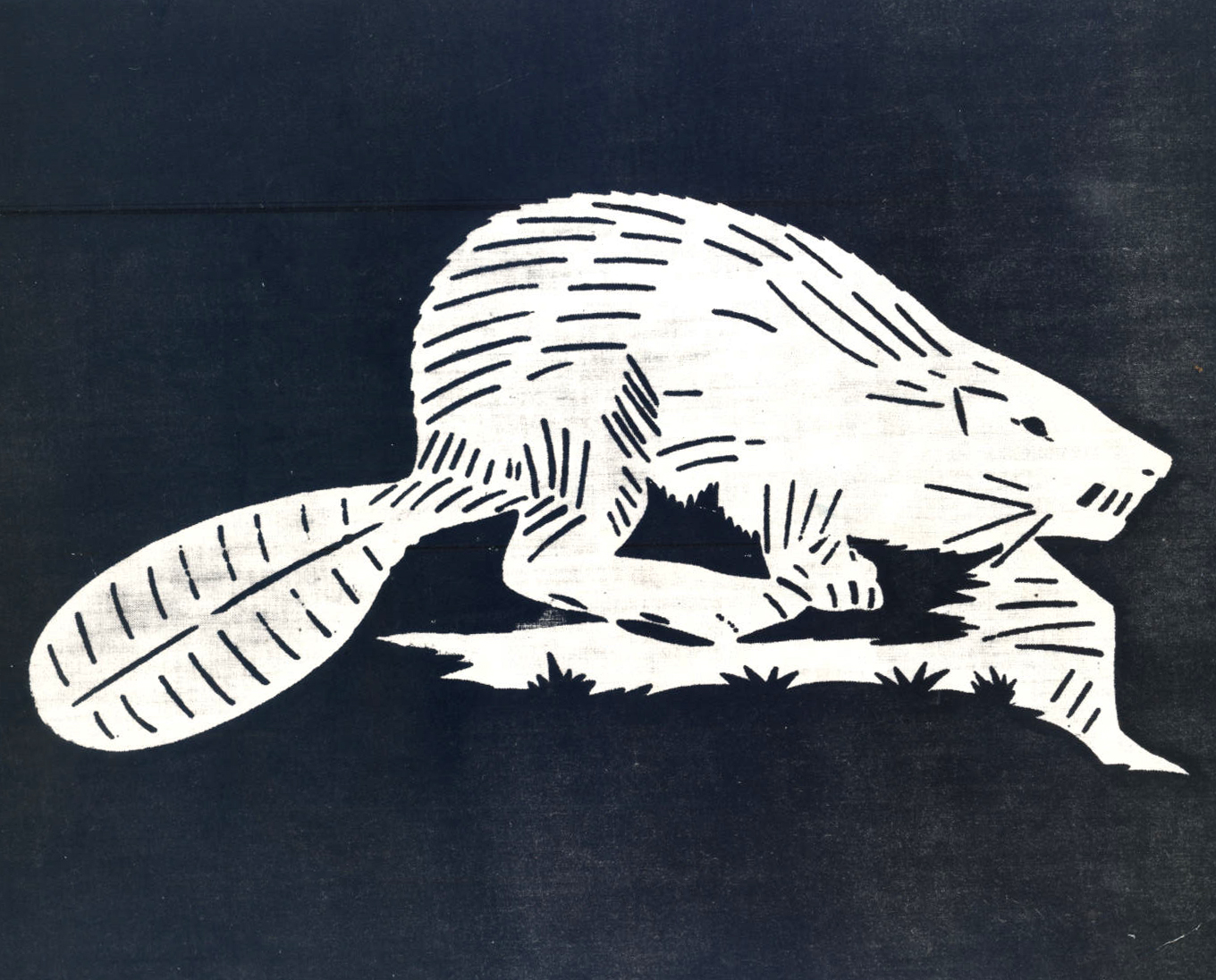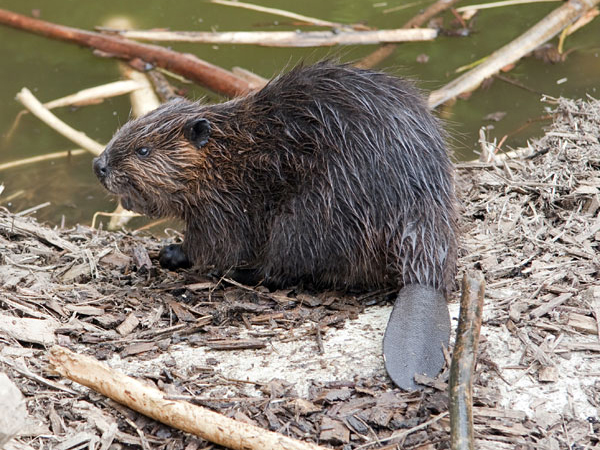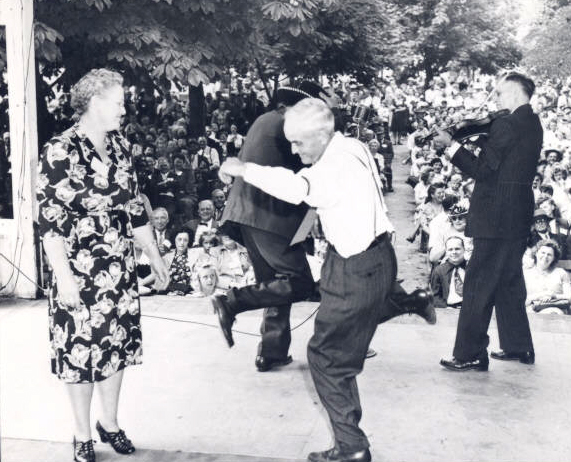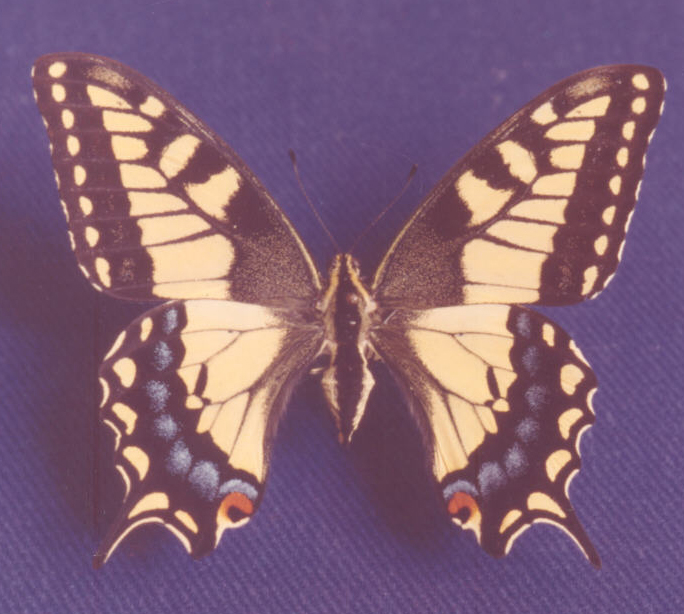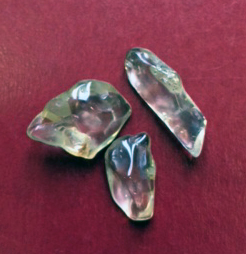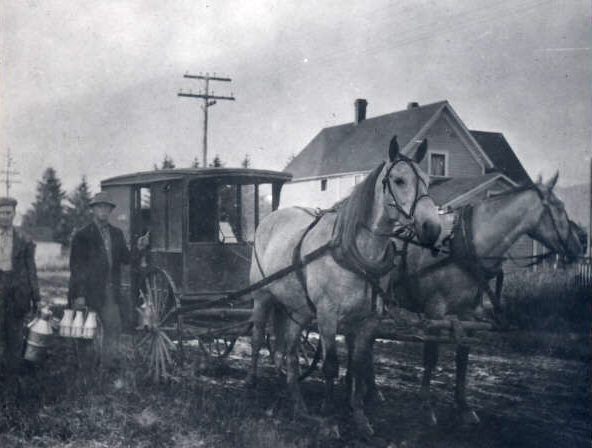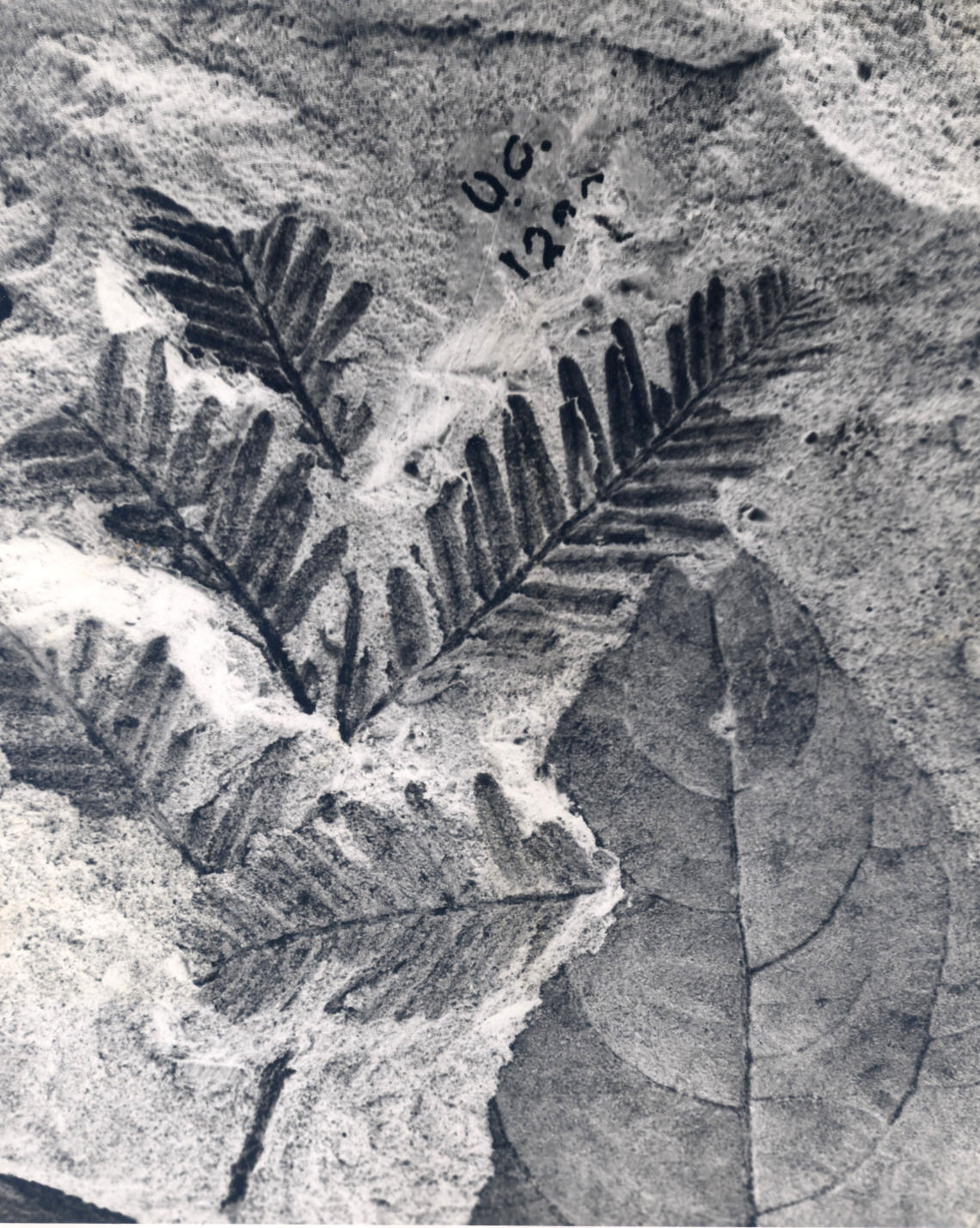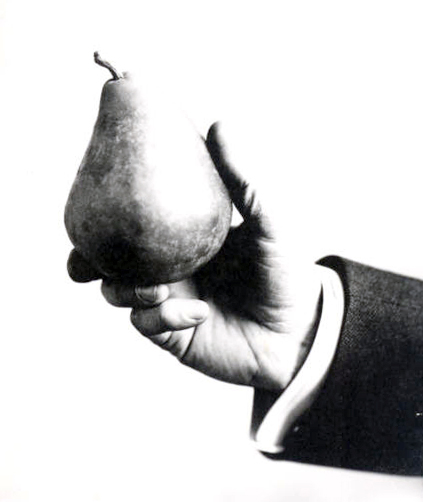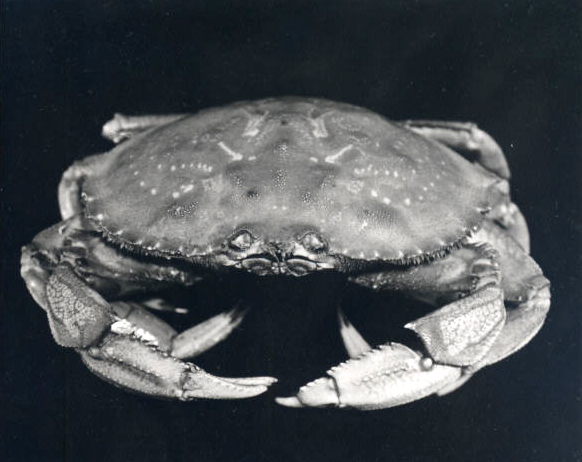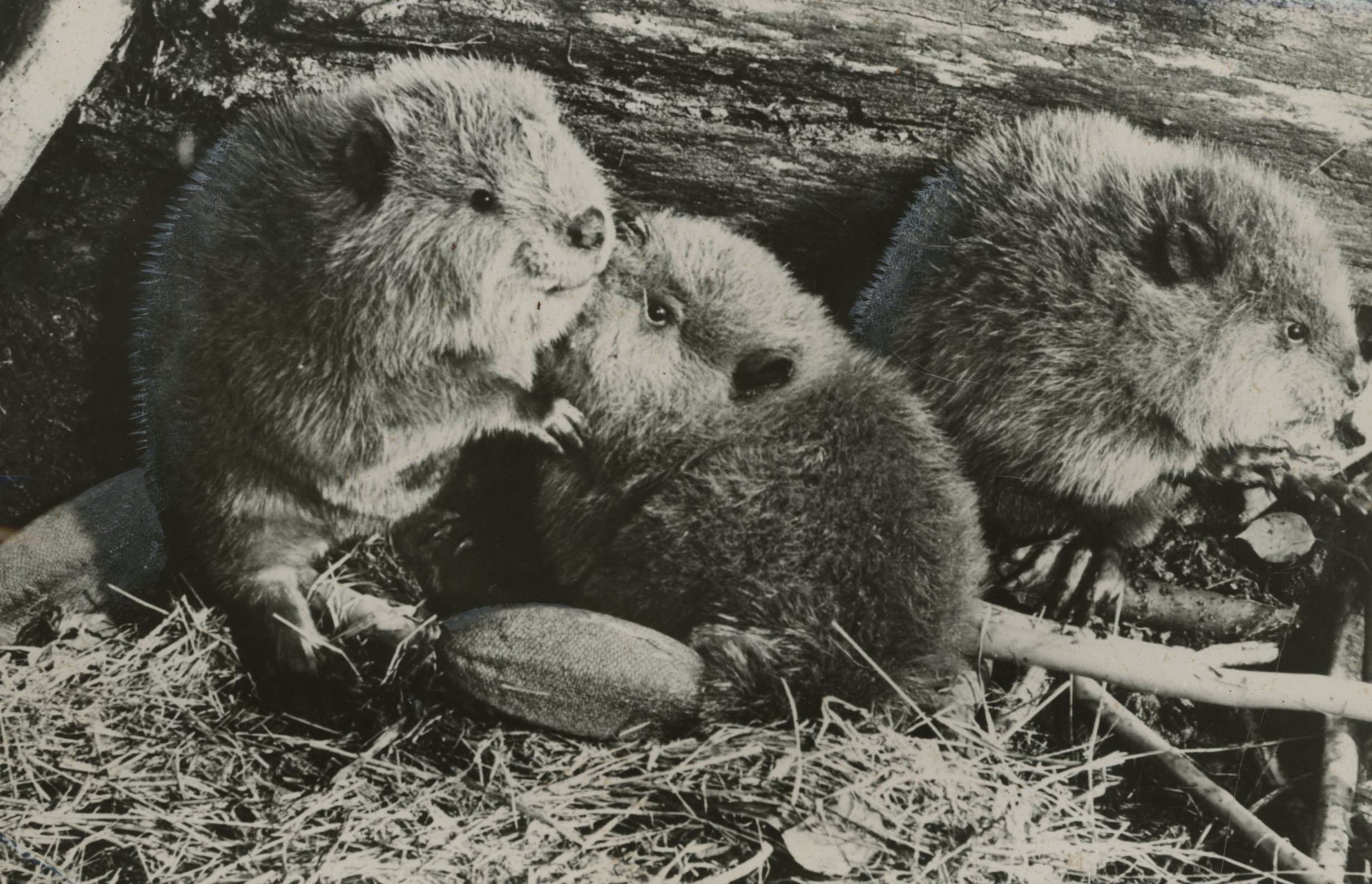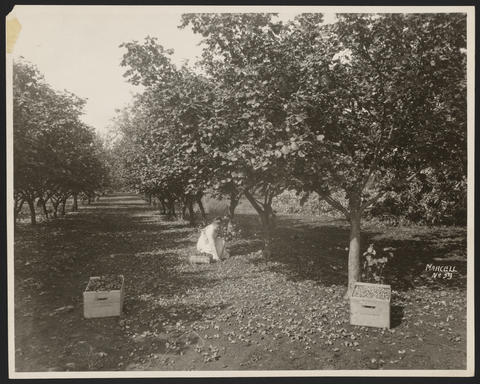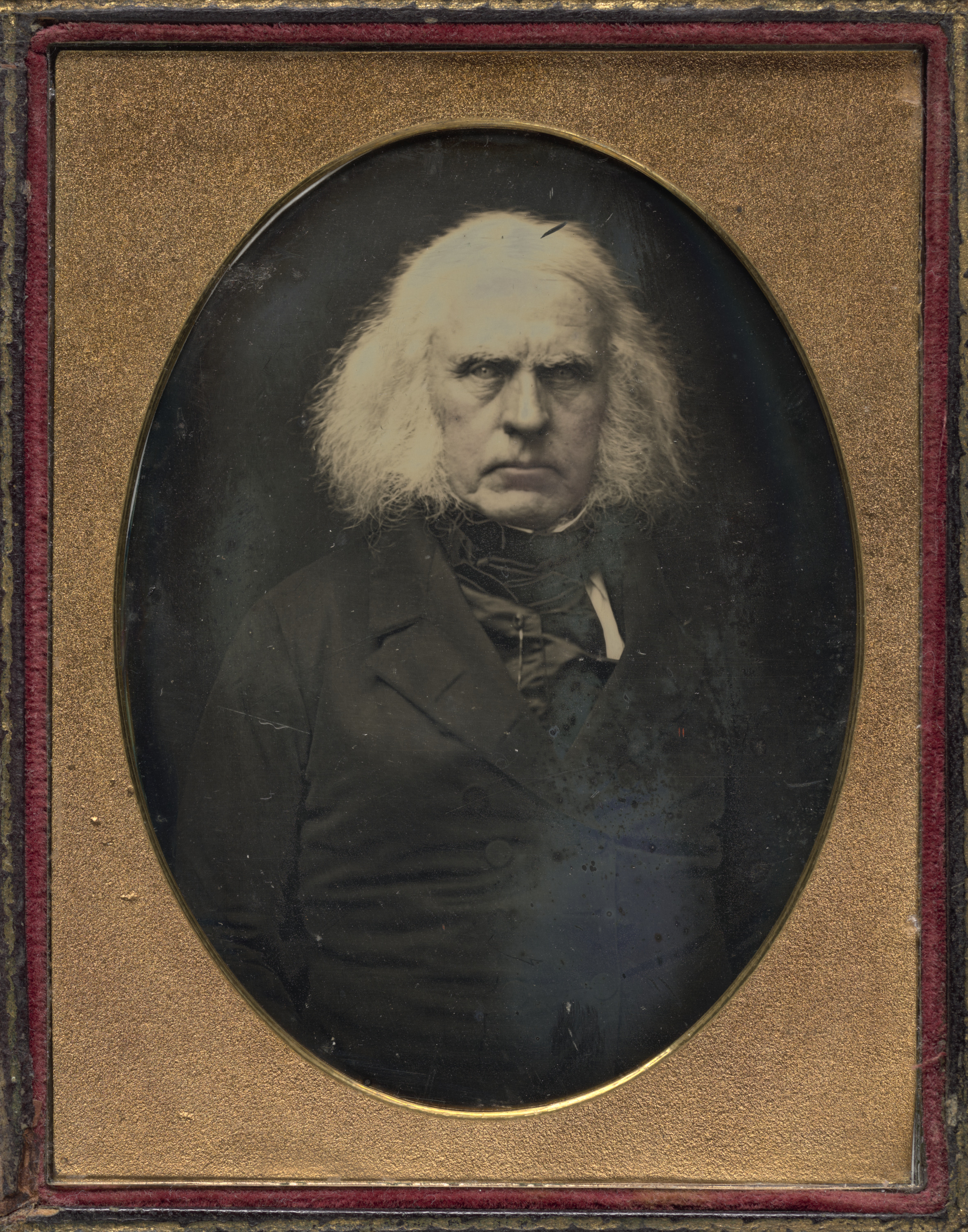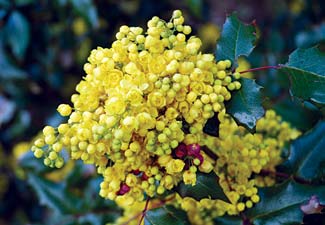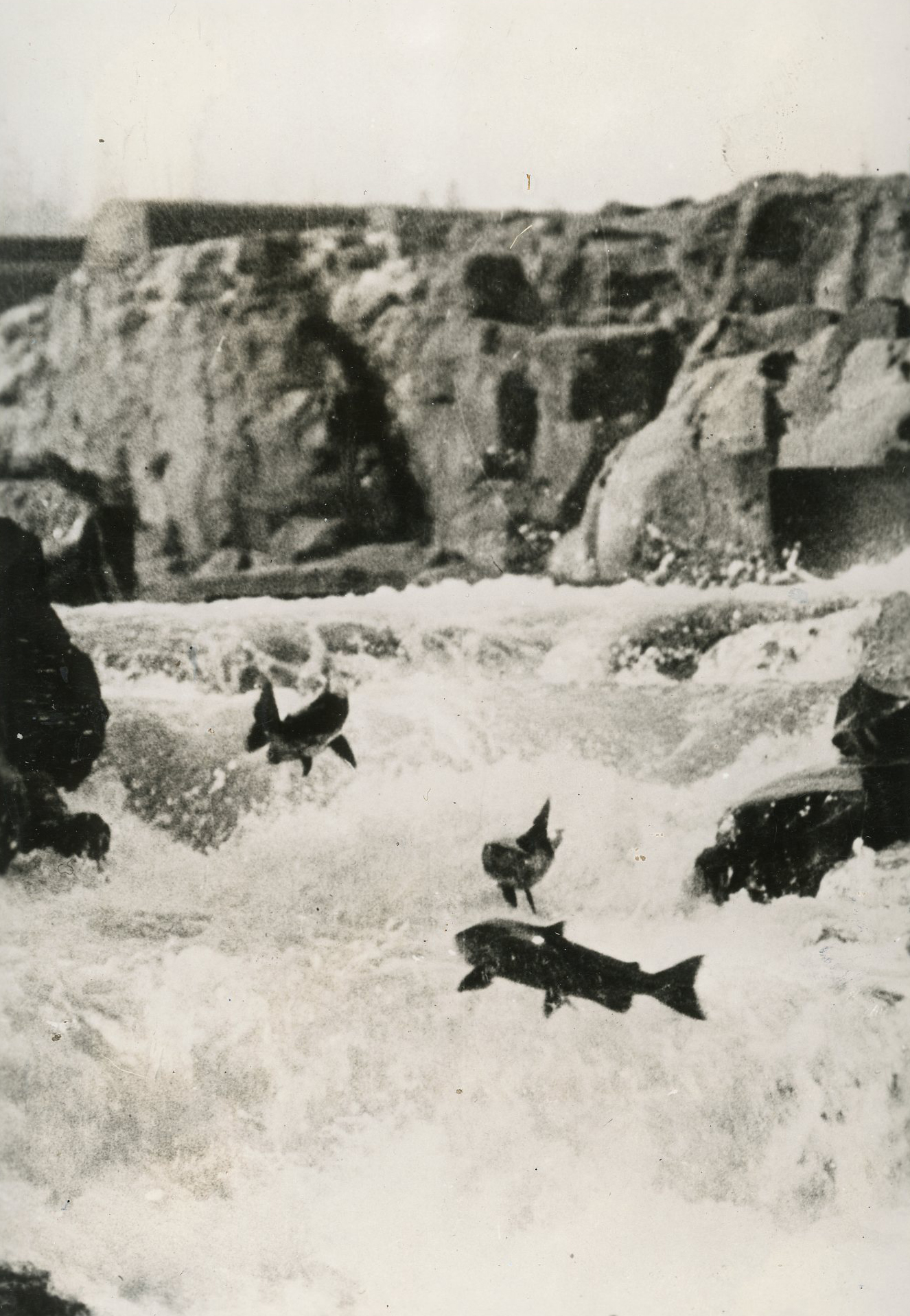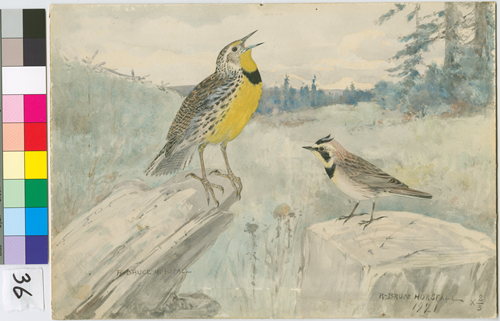Oregon has a number of officially designated symbols, ranging from those that are essential to the state government, such as the seal and flag, to some that some may consider superfluous, including the state dance and gemstone. Legislators and proponents of state symbols have argued that there is an economic benefit to identifying state symbols, either in increased tourism or in raising the profile of Oregon products. As of 2011, Oregon had twenty-two symbols, but it is likely there will be more. Some states have twice as many symbols as Oregon, which has yet to choose a state muffin, crustacean, grass, reptile, or toy, among others. In the last several decades, failed symbols include a state waltz (Oregon Waltz) and a horse (Kiger Mustang).
State Seal (1859)—Oregon’s provisional government (1843-1848) used a simple seal with three bundles of wheat and a salmon under the banner “Oregon.” The territorial seal (1848-1859) included the motto “Alis Volat Propriis” (see Motto). It showed a plow and a merchant ship, surrounded by a Native American, a beaver, five stars, and an eagle about to take flight. In 1859, the newly established state legislature adopted a new seal, which has undergone only minor changes since. On the seal is written, “The Union” (see Motto). Pictured are a covered wagon; an elk; a plow; a pick ax; and two ships, a departing British man-of-war and an arriving American merchant ship. Surrounding the symbols are thirty-three stars, signifying that Oregon was the thirty-third state accepted into the United States.
Flower: Oregon grape (1899)—At their annual convention in 1892, the Oregon Horticultural Society nominated the Oregon grape (Mahonia aquifolium) as the state flower, beating out the bearded gaillardia, Washington lily, wake robin, and madrone. The state legislature officially adopted the Oregon grape in 1899. The Oregon grape is not a grape but a small broadleaf evergreen shrub, native to the Pacific states, in the barberry family. The berries are edible, but bitter. Some people use the Oregon grape in jellies or jams, and also in alternative medicine.
Flag (1925)—Oregon’s flag, adopted in 1925, is the only state flag with a different image on each side. One side shows a shield from the state seal, under the banner “State of Oregon,” and includes the date 1859; the year Oregon became a state. On the reverse side is a beaver. The parade version of the flag has gold fringe. The Oregonian reported that the beaver was placed on the flag because it “was the primary incentive for early exploration and it dominated the fur trade era in this part of the Northwest . . . its appropriateness is intensified also by its commonly accepted attributes. It is the universal symbol of thrift and industry and constructive endeavor—qualities as essential now as ever.” Portland's Meier & Frank Company made the first flag, which was unfurled on April 11, 1925. Until that time, Oregon used a blue military regimental flag.
Bird: Western Meadowlark (1927)—In 1927, the Oregon Audubon Society sponsored a contest among schoolchildren to choose the state bird. The western meadowlark (Sturnella neglecta) won by a large margin (40,000 out of 75,000 votes), and Governor Isaac L. Patterson officially proclaimed it the state bird. The state bird is the only Oregon symbol not officially chosen by the state legislature. Oregon is one of seven states to favor the species. The western meadowlark is native to western North America, favoring open grasslands. In Oregon, the species has declined in the Willamette Valley and is more commonly found in the eastern part of the state. The birds nest on the ground and are also ground feeders, eating insects, invertebrates, grains, and seeds. The western meadowlark is known for its lilting melody.
Song: Oregon, My Oregon (1927)—Oregon’s state song was the result of a 1920 contest sponsored by the Society of Oregon Composers. Five judges chose John A. Buchanan’s poem from 212 entries, and Society vice-president Henry B. Murtagh set the poem to music. Buchanan was a city judge in Astoria and a former state legislator. Murtagh was well-known silent-film theater organist, then living in Portland. The Society shortened and edited Buchanan’s poem, “Oregon” and renamed it “Oregon, My Oregon.” The Oregon legislature officially designated “Oregon, My Oregon” as the state song in 1927. On June 7, 2021, the Oregon State Legislature passed a resolution to modify the lyrics to reflect the "significant cultural, historical, economic and societal evolution in Oregon." The tune remains the same.
Tree: Douglas-fir (1939)—The Oregon legislature chose the Douglas-fir (Pseudotsuga menziensii) as the state tree in 1939 at the request of the Daughters of the American Revolution. It was the eighth state to choose an official tree. The choice for Oregon was an obvious one. Douglas-firs are and have been abundant in the state and played an important role in the timber industry. In 1939, the Oregonian reported that the tree was a “magnificent emblem,” known for growing tall and wide. “It furnishes the finest and largest saw-timber of any tree in the world.” Douglas-firs were named for botanist David Douglas, who traveled in Oregon in 1825-1827. Douglas-firs are not actually firs, but are in the Pseudotsuga genus, meaning “false hemlock.”
Father of Oregon: John McLoughlin (1957)—The state legislature gave Dr. John McLoughlin (1784-1857) the title of “Father of Oregon” in 1957, a century after his death. McLoughlin first came to the Pacific Northwest in 1824 as the chief factor of the British Hudson’s Bay Company’s Columbia District. He established Fort Vancouver in 1825 and was the most influential regional figure until 1846, when he retired, settled in Oregon City, and became an American citizen. In naming McLoughlin the “Father of Oregon,” the legislature recognized his role in settling Oregon and his aid to many early Oregon immigrants, whose presence eventually undermined British claims to the region.
Fish: Chinook Salmon (1961)—The Chinook salmon (Oncorhynchus tshawytscha) was named the state fish in 1961. Known as “Kings,” Chinook are the largest and most commercially prized of the Pacific Northwest salmon species. Since the late nineteenth century, over-fishing, hydroelectric dams, and habitat destruction have dramatically reduced numbers of Oregon Chinook salmon. Many runs, recognized as distinct populations, have federal endangered and threatened status. Chinook salmon are native to the Pacific Ocean and western North America. They are born in freshwater rivers and streams and then migrate to the ocean. At the end of their life cycle, they migrate back to their spawning grounds and reproduce before dying.
Rock: Thunder Egg (1965)—In 1965, the Oregon Museum of Science and Industry (OMSI) asked Oregonians to choose a state rock. Voters chose the thunder egg “by a landslide,” according to the Oregonian. In officially recognizing the thunder egg, the legislature described it as a “remarkable and colorful agate-filled spherical mass of silicified claystone, and rhyolite.” Thunder eggs are similar to geodes and are found in central and eastern Oregon. While the exterior of a thunder egg appears ordinary, the interior reveals agate, jasper, or opal. The town of Nyssa celebrates the state rock each year with a "Thunderegg Days" festival.
Animal: Beaver (1969)—The “Beaver State” was late in officially recognizing the American Beaver (Castor canadensis) as a state symbol. After the Oregonian called attention to the oversight in 1968, Governor Tom McCall and Secretary of State Clay Myers Jr. nominated the beaver as the state animal. The legislature adopted it in 1969. The association of the beaver with the state is longstanding. In 1849, the Oregon provincial government issued “beaver money” with an image of the icon, and the animal was included on the territorial seal and state flag. Although fur trappers nearly exterminated the species in the region in the nineteenth century, beavers have recovered their population in Oregon. Known for their engineering abilities, beavers create ponds by damming creeks and rivers. They are mostly nocturnal, weigh between thirty and seventy pounds, and are strong swimmers. Beavers eat bark, grasses, and other plants found along streams and rivers.
Dance: Square Dance (1977)—At the request of the Oregon Federation of Square and Round Dance Clubs, the state legislature named the square dance the official state dance in 1977. The legislation was part of a national campaign by square dance clubs that resulted with nineteen states declaring it their state’s dance. The effort to have it named the national folk dance has not yet been successful. The square dance features eight dancers (four couples) in a small square formation, accompanied by guitar, fiddle, banjo, or accordion. There are about 100 clubs in the Oregon Federation of Square and Round Dance Clubs, formed in 1956.
Insect: Oregon Swallowtail (1979)—After the rain beetle failed to become the state insect in 1977, because it was harmful to orchard fruits, Portland Zoo director Warren Iliff nominated the Oregon swallowtail (Papilio oregonius), a large yellow and black butterfly native to the Northwest. The state legislature approved this selection in 1979. The species lives in sagebrush canyons in eastern Oregon and in the Columbia, Deschutes, and Snake river basins.
Mother of Oregon: Tabitha Moffatt Brown (1987)—Oregon pioneer Tabitha Moffatt Brown (1780-1858) was founder of a school for orphans that grew into the Tualatin Academy, a high school in Forest Grove. The institution later became Pacific University. She is also known for having survived a difficult 1846 overland journey from Missouri to Oregon as a sixty-six-year-old widow. Brown and her traveling party took a shortcut into Oregon Country on the Applegate Trail. Moffatt later remembered: “We had sixty miles of desert without grass or water, mountains to climb, cattle giving out, wagons breaking, emigrants sick and dying, hostile Indians to guard against by night and day.” In selecting Tabitha Moffatt Brown as the “Mother of Oregon,” the state legislature declared that she “represents the distinctive pioneer heritage and the charitable and compassionate nature of Oregon's people."
Gemstone: Oregon sunstone (1987)—In 1987, the legislature named the Oregon sunstone as the state gemstone. “The development and marketing of these beautiful gems," the legislature stated, "can contribute to tourism and the economic development of the high desert country of southeastern Oregon.” Sunstones, found in Lake and Harney counties, are transparent and are found in a variety of colors. The U.S. Bureau of Land Management allows the public to collect sunstones in the Rabbit Basin near the town of Plush.
Motto: "She Flies With Her Own Wings" (1987)—In 1859, the state of Oregon adopted a new seal, which included “The Union,” likely an affirmation of legislators’ unionist sentiments immediately preceding the Civil War. During Oregon’s centennial in 1959, the state legislature officially chose “The Union” as the state motto. In 1987, the Oregon legislature changed the state motto from “The Union” to “She Flies With Her Own Wings,” the unofficial motto from Oregon’s territorial period. Supporters of the change argued that “She Flies With Her Own Wings” reflected Oregon’s independent nature. The phrase comes from the Latin “alis volat propiis,” which was first added to Oregon’s territorial seal by Jesse Quinn Thornton, a judge for Oregon’s provisional government and later a state legislator. While it is now translated as “She Flies With Her Own Wings,” Thornton translated the phrase as “He Uses His Own Wings.” He said it was “an allusion to the general facts of the history of colonization of Oregon and the establishment and maintenance of the provisional government without aid of the mother country.”
Nut: Hazelnut (1989)—The Oregon state legislature designated the hazelnut as the state nut in 1989, recognizing the economic and historical significance of Oregon’s hazelnut farmers. Oregon farmers produce less than 5 percent of the world’s hazelnuts but 99 percent of the national crop. Hazelnuts have been traditionally known as filberts in Oregon, but the Oregon Hazelnut Marketing Board adopted “hazelnut” in 1981 to reflect more common terminology. Oregon farmers began importing European varieties of hazel trees as early as 1876. By the 1920s, there was a notable industry. There are fifteen species of hazel and filbert shrubs and trees in the genus Corylus, including a variety native to the western United States (Corylus cornuta var. californica). Native Americans ate the nuts of the native hazel, which is an understory shrub common in Northwest forests.
Seashell: Oregon hairy triton (1991)—In 1991, at the request of the Oregon Society of Conchologists, the state legislature named the shell of the Oregon hairy triton (Fusitriton oregonensis) the state seashell. The Oregon hair triton is a snail that grows to a length of three to five inches. Its range includes much of the northern Pacific Ocean. Unverified sources attribute the snail's original naming to botanist J.H. Redfield, who is said to have chosen the name in 1848 to honor Oregon's territorial status.
Beverage: Milk (1997)—In 1997, elementary school students from Tillamook requested that the state legislature designate milk as the state beverage, which it did, making Oregon one of nineteen states with milk as its official beverage. In a joint resolution, the Oregon house and senate announced that “milk production and the manufacture of dairy products are major contributors to the economic well being of Oregon agriculture.” In 2007, Governor Ted Kulongoski proclaimed February “Oregon Dairy Farmer Month,” and the Dairy Farmers of Oregon installed a milk-vending machine in the state capitol.
Mushroom: Pacific Golden Chanterelle (1999)—At the request of Oregon Mycological Society member Kevin Winthrop, the legislature named the Pacific golden chanterelle (cantharellus formosus) the official Oregon mushroom in 1999. Winthrop testified that the annual harvest of the wild mushrooms was valued at $25 million. In a joint resolution, the house and senate found that “more than 500,000 pounds of Pacific golden chanterelles harvested annually represent a large portion of Oregon’s commercial mushroom business.”
Fossil: Metasequoia (2005)—Oregon became the last western state to name a state fossil in 2005, when the state legislature selected ancient remains of the Metasequoia tree, or dawn redwood. Newport amateur paleontologist Guy DiTorrice and eleven-year-old MacKenzie Smith of Tigard both testified in favor of the fossil, which faced no competition. While Metasequoia trees went extinct in Oregon about 5 million years ago, abundant fossilized remains have been found in the state. The trees have been growing again in Oregon since the late 1948, shortly after scientists discovered living Metasequoia trees in China.
Fruit: Pear (2005)—At the request of the Pear Bureau Northwest, the 2005 Oregon legislature named the pear the state fruit. Teenage girls from Hood River, representing that city’s “Blossom Court,” testified before lawmakers in favor of the measure. In their resolution, legislators noted that pears were Oregon’s “top-selling tree fruit crop and its 10th largest agricultural commodity.” Historically, Oregon’s pear industry has been centered in the Hood River and Rogue River valleys.
Crustacean: Dungeness Crab (2009)—In a hands-on civics lesson, fourth graders from West Linn's Sunset Primary School successfully lobbied the legislature to declare the Dungeness crab (Cancer magister) the state crustacean in 2009. In their campaign, students worked with the Oregon Dungeness Crab Commission and testified before legislators. The industry-funded crab commission reports that while harvests can fluctuate radically, Oregon's fishermen harvest an average of about 10 million pounds of Dungeness crab each year, making "the Dungeness crab fishery the most valuable 'single species' fishery in Oregon." Dungeness crabs live in coastal waters and thrive in estuaries. The state government regulates the fishery for sustainability, with restricted seasons, size limits, and a ban on harvesting female crabs.
Jory soil (2011)—A nearly twenty-year effort by the Oregon Soil Science Society culminated in the legislature designating Jory soil as a state symbol. The society unofficially adopted Jory soil in 1993 as part of a nationwide effort by soil scientists to recognize soil’s importance for agriculture and the environment. Members aligned with state representative Mitch Greenlick and with Richard Page, a descendent of the Jory family for which the soil was named. After a failed 2007 attempt, Greenlick ensured approval in 2011 by threatening to block unrelated legislation.
USDA soil scientists first identified the soil in 1970 on Jory Hill, which was named for 1847 Marion County pioneers James and Mary Jory. The red soil largely came from ancient volcanic basalt flows that originated in eastern Oregon. In the Willamette Valley, the rock weathered into a deep soil that drains well and is optimal for growing Christmas and filbert trees, berries, and other crops.
Vegetable: Potato (2023)—The battle between onions and potatoes for the official state vegetable ended in June 2023 when a pro-potato bill submitted by State Senator Bill Hansell (Umatilla) passed the Oregon Senate and House. Although Idaho and Washington are the top growers of potatoes in the U.S., Oregon is not far behind in production: the state's farmers grew over 2.5 billion pounds of potatoes in 2021. Hansell pointed to Oregon's high production ranking in support of his bill, as well as to the world-wide popularity of the tater tot—invented in Ontario, Oregon in 1953.
-
![]()
State of Oregon seal.
Courtesy Oreg. Hist. Soc. Research Library, 37832
-
![]()
Oregon grape.
Courtesy Oreg. Hist. Soc. Research Library, OrHi85210
-
![]()
Oregon grape, sketch.
Courtesy Oreg. Hist. Soc. Research Library, 26428
-
![]()
State of Oregon flag (front).
Courtesy Oreg. Hist. Soc. Research Library, 24398-A
-
![]()
Western Meadowlark.
Courtesy Oregon Dept. of Fish and Wildlife -
![Drawing of Douglas Fir branch.]()
Douglas fir, drawing of.
Drawing of Douglas Fir branch. Courtesy USDA-NRCS PLANTS Database
-
![John McLoughlin]()
John McLoughlin.
John McLoughlin Courtesy Oreg. Hist. Soc. Research Lib., OrHi067763
-
![White salmon trout from Clark's journal]()
White salmon trout from Clark's journal.
White salmon trout from Clark's journal Courtesy Oreg. Hist. Soc. Research Lib., OrHi96334
-
Thunder eggs.
Courtesy Oregon Encyclopedia
-
![]()
Beaver, on the Oregon state flag.
Courtesy Oreg. Hist. Soc. Research Library, 4733
-
![]()
Beaver.
Courtesy Oregon Department of Fish and Wildlife
-
![]()
Square dancing at Jantzen Beach, 1948.
Courtesy Oreg. Hist. Soc. Research Library, 018039
-
![]()
Swallowtail butterfly.
Courtesy Oreg. Hist. Soc. Research Library, OrHi88275
-
![Tabitha Moffat Brown.]()
Brown, Tabitha Moffat, OrHi 53563.
Tabitha Moffat Brown. Oreg. Hist. Soc. Research Lib., OrHi 53563
-
symbols.
Courtesy Oregon Encyclopedia
-
![]()
Milk delivery wagon, Tillamook, 1911.
Courtesy Oreg. Hist. Soc. Research Library, OrHi26407
-
![]()
Metasequoia fossil, 1948.
Courtesy Oreg. Hist. Soc. Research Library, ba013437
-
![]()
Pear.
Courtesy Oreg. Hist. Soc. Research Library, 008196
-
![]()
Dungeness crab, 1980.
Courtesy Oreg. Hist. Soc. Research Library, 023861
Related Entries
-
![Beaver]()
Beaver
The American Beaver (Castor canadensis) is often called “nature’s en…
-
![Chanterelle Mushrooms]()
Chanterelle Mushrooms
Chanterelle mushroom refers to a group of mushrooms that usually have a…
-
![Douglas-fir]()
Douglas-fir
Douglas-fir (Pseudotsuga menziesii), perhaps the most common tree in Or…
-
![Hazelnuts]()
Hazelnuts
Hazelnuts, also called filberts, have provided food for Indigenous peop…
-
![John McLoughlin (1784-1857)]()
John McLoughlin (1784-1857)
One of the most powerful and polarizing people in Oregon history, John …
-
![Oregon Grape]()
Oregon Grape
Oregon grape is a common name for members of the barberry family, Berbe…
-
![Oregon, My Oregon (state song)]()
Oregon, My Oregon (state song)
Oregon’s state song, “Oregon, My Oregon,” was composed by Henry B. Murt…
-
![Oregon State Flag]()
Oregon State Flag
Oregon is the only state in the country whose flag has a different imag…
-
![Salmon]()
Salmon
The word “salmon” originally referred to Atlantic salmon (Salmo salar),…
-
![Tabitha Moffat Brown (1780-1858)]()
Tabitha Moffat Brown (1780-1858)
Of the 158 names inscribed in the legislative chambers of the Oregon St…
-
![Western Meadowlark]()
Western Meadowlark
On a fence post in Wheeler County, a sandy brown bird delivers a rich s…
Map This on the Oregon History WayFinder
The Oregon History Wayfinder is an interactive map that identifies significant places, people, and events in Oregon history.
Further Reading
All: "State Symbols: Flag to Motto," Oregon Blue Book, Salem: Oregon State Archives, https://sos.oregon.gov/blue-
Animal: “Slighted Beaver,” Oregonian, Feb. 19, 1968, p. 18; "Beaver: Castor canadensis," National Geographic, http://animals.nationalgeographic.com/animals/mammals/beaver.html.
Beverage: Suo, Steve, “Got Milk? Oregon Might – as Official State Beverage,” Oregonian, Feb. 24, 1997; Dairy Farmers of Oregon, http://www.dairyfarmersor.com/.
Bird: “Meadowlark Voted Official State Bird,” Oregonian, June 1, 1927, p. 1; "Western Meadowlark," Wichita, Kansas: Great Plains Nature Center.
Crustacean: Oregon Dungeness Crab Commission. "Dungeness crab," Netarts Bay Today, http://www.netartsbaytoday.org/html/dungeness_crab.htmll.
Dance: Oregon Federation of Square and Round Dance Clubs, http://www.squaredance.gen.or.us/.
Father: "John McLoughlin (1784-1857)," Oregon Historical Society Oregon History Project.
Flag: “Oregon Flag Finished, Oregonian, April 12, 1925, p. 6; “Beaver on the Flag,” Oregonian, May 29. 1925, p. 10.
Flower: "Mahonia aquifolium," Corvallis: Oregon State University, http://oregonstate.edu/dept/ldplants/maaq-i.htm; "Mahonia aquifolium," Columbus: Ohio State University Horticultural & Crop Science, http://hcs.osu.edu/hcs/tmi/plantlist/ma_olium.html; “The Oregon Grape,” Oregonian, Dec. 24, 1903, p. 4.
Fossil: "Oregon’s Fossils: Citizens of the Past," Oregon Historical Society.
Gemstone: "Oregon Sunstone Proclaimed Oregon's Official State Gemstone," Oregon Geology 49:10 (Oct. 1987), 128-129, www.oregongeology.org/pubs/OG/OGv49n10.pdf.
Mother: Terry, John, “Stature Rates Mother Symbol Status,” Oregonian, March 31, 2002; “A Brimfield Heroine – Mrs Tabitha Brown,” Oregon Historical Quarterly 5:2, (Winter 1904), 199-205.
Motto: "State Motto Timeline," Salem: Oregon State Legislature, https://sos.oregon.gov/blue-
Mushroom: Kuo, Michael, "Cantharellus formosus: The Pacific Golden Chanterelle," MushroomExpert.Com, Feb. 2006, http://www.mushroomexpert.com/cantharellus_formosus.html.
Nut: Ames, Sarah B., “Hazelnut Shells Chinquapin in Battle to Represent State,” Oregonian, April 4, 1989; "Oregon Hazelnuts: Indulgence in a Nutshell," Oregon Hazelnut Marketing Board; Goranson, Eric, “Hazelnut Seller Gets Cracking,” Oregonian, Aug. 20, 1987; Long, Charles M., Oregon’s First Century of Farming: A Statistical Record of Agricultural Achievement and Adjustment, 1859-1958, Corvallis: Oregon State University, 1959; Rost, Bob., “The Nutty Professors,” Oregon's Agricultural Progress, Fall 1998. http://oregonprogress.oregonstate.edu/fall-1998/nutty-professors.
Pear: Cole, Michelle, “Oregon’s Cornucopia of Symbols Brings Together Pears and Politics,” Oregonian, March 18, 2005.
Rock: Brogan, Phil, “Thousands Support Thunderegg as Official Oregon Rock,” Oregonian, March 10, 1963; "Thundereggs," Nature of the Northwest, http://www.naturenw.org/rock-thundereggs.htm.
Seal: "Oregon Focus: State Symbols: Seal." Oregon Blue Book. https://sos.oregon.gov/blue-
Seashell: "Oregon or Hairy Triton," Alaska Fisheries Science Center, National Marine Fisheries Service, Cowles, Dave, "Fusitron oregonensis," Walla Walla University Rosario Beach Marine Laboratory, 2005.
Soil: “Jory: Oregon’s State Soil.” Washington, D.C.: U.S. Department of Agriculture Natural Resources Conservation Service, n.d. Mapes, Jeff. “Jory Soil, Not Just Any Dirt, Is Named Oregon's Official State Soil.” Oregonian, May 23, 2011. http://www.oregonlive.com/politics/index.ssf/2011/05/jory_soil_not_just_any_dirt_is.html; Page, Richard M. “Senate Committee on Environment and Natural Resources, Testimony on HCR 3.” May 12, 2011.
Song: "State Song of Oregon," National Anthems of the World Organisation, http://www.national-anthems.org/anthems/naw_id/SSA-037; Tucker, Kathy, "Sheet Music Cover, Oregon, My Oregon," Oregon Historical Society Oregon History Project,http://ohs.org/education/oregonhistory/historical_records/dspDocument.cfm?doc_ID=000D5641-3960-1EA4-B96080B05272006C.
Tree: Averill, Ed F., “New State Tree is Ancient Fir,” Oregon Journal, April 30, 1939; Oldham, Kit, "David Douglas arrives at Fort Vancouver to begin two years of botanical exploration on April 20, 1825," History Link, April 20, 2005,

